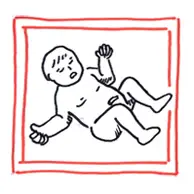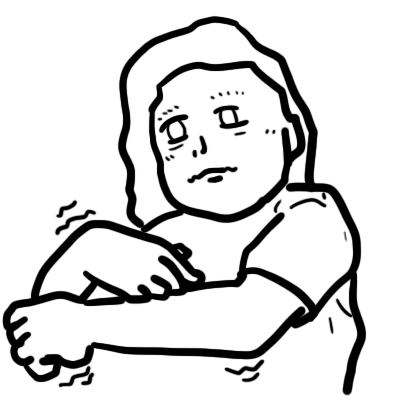Overview
Developmental Dyplasia of the hip (DDH) is previously known as congenital dislocation of the hip (however name changed as some of the hip problems develop after birth). Spectrum of condition related to development of the hip in infants and young children. Includes abnormal development of the acetabulum and proximal femur + mechanical instability of the hip joint. Usually involves shallowness of the acetabulum
Instability of the hip in the newborn include:
- Dislocatable hips
- Acetabular dysplasia
- Sublaxation of femoral head
- Dislocated Femoral head
| Definition Hip Dysplasia: refers to an abnormality in the size, shape, orientation, or organization of the femoral head, acetabulum, or both Acetabular dysplasia: Characterized by an immature, shallow acetabulum and can result in subluxation or dislocation of the femoral head Subluxed hip: The femoral head is displaced from its normal position but still makes contact with a portion of the acetabulum Dislocated hip: There is no contact between the articular surface of the femoral head and the acetabulumUnstable hip: Hip joint that is reduced in the acetabulum but can be provoked to subluxate or dislocate Developmental Hip Dysplasia (DDH): Spectrum of hip abnormality after birth. Ithas replaced congenital dislocation of the hip because it more accurately reflects the full spectrum of abnormalities that affect the immature hip. DDH can predispose a child to premature degenerative changes and painful arthritis. |
| Video: Congenital Hip Dysplasia |
Hip Anatomy
Overview
- The Hip joint is a ball and socket joint (largest joint in the body)
- The head of the femur articulates with the acetabulum of the hip bone
The acetabulum
- Horseshoe shaped structure
- The depth of the acetabulum increases in puberty
- A fibrocartilaginous ring called the acetabular labrum deepens the acetabulum.
The Femur
- Longest bone in the body
- The head of the femur articulates with the acetabulum of the hip bone
- The head of the femur i covered with hylane cartilage except for fovea capitis which serves as attachment for ligamentum teres.
Ligaments of the hip joint
- Intra-articular
- Ligamentum teres
- Transverse acetabular ligament
- Acetabular labrum
- Extra-articular
- Iliofemoral ligament
- Pubofemoral ligaemen
- Ischiofemoral ligament
Vascular supply
- Medial and lateral femoral circumflex→ supplies proximal femur
- Branches of the obturatory Artery → supplies femoral Head
- Branches from the superior and inferior gluteal arteries → supplies acetabulum
Aetiology and Risk Factors
Risk factors for DDH should be identified in all children
- Breech presentation at >34 weeks gestation
- Female baby
- Oligohydraminiosis
- Big baby (>4kg)
- First born baby
- Family history
| Remember the 4F's associated with DDH: Female gender, First born child, Foot first (breech), Family history. |
Clinical Manifestation
Newborns have physiological laxity of the hip and immature acetabulum → resolves within first weeks of life
Screening occurs for DDH during well baby checks
- First day of life and at discharge from the maternity ward + at 6 weeks, 3 months, 6 months and 1 year
Barlow maneuver
- Hip flexed to 90° and adducted
- Examiner places hand on knee
- Applies posterior pressure through the hip in attempt to dislocate
→ Positive if hip dislocation is palpable (often described as a clunk)
Ortolani maneuver
- Hip is flexed to 90° and abducted
- Examiner places fingers laterally over the greater trochanter or hip joint.
- Applies anterior pressure over the trochanter in an attempt to identify a dislocated hip that is relocatable
→Positive = sensation of palpable ‘clunk’ that represents the reduction of dislocation hip
Galaezzi Sign
- Position child supine with hips and knees flexed (heels to bum)
- Affected side knee is lower due to posterior displacement of the femoral head
→Positive if inequality in the height of the knees
Diagnosis
- Acetabular immaturity - Difficult to differential until child is over 3 months
- Proximal femoral focal deficiency - Thigh is large and markedly shorter
- Residual effects of septic arthritis - Acute presentation with fever, irritability and poor ffeding , pain in intrernal roation
- Fracture of femoral neck - X-ray finding differentiate
Investigations
Ultrasound
- Primary imaging technique for DDH assess morphology and stability →Uses static and dynamic imaging (modified Barlow manaeuver)
- Performed at 4-6 weeks
- Result suggestive of DDH: subluxation on provaction testing + abnormal relationship between femoral head and acetabulum
Hip X-ray - Not recommended in infants <6 months but after this is prefered imaging method
| Remember Ultrasonography should be ordered for infants six weeks to six months of age to clarify a clinical finding suggestive of DDH, assess a high-risk infant, and monitor DDH as it is observed or treated. |
Treatment
Management Goal of treatment in DDH is to achieve and maintain reduction of the femoral head in the true acetabulum by closed or open means. The earlier treatment is initiated, the greater the success and the lower the incidence of residual dysplasia and long-term complications.
- Pavlik Harness
- Spica Casting + closed or open reduction
| Remember Avascular necrosis of the femoral head has been reported with Pavlik harness treatment and may be related to hyperabduction. |
Complications and Prognosis
Complications
- Avascular necrosis from pavlik harness
- Residual acetabular dysplasia
- Degenerative joint disease (accelaterated osteoarthritis)
- Knee valgus
- Back pain
- Treatment-related nerve palsy
Prognosis is dependent upon the age at presentation, the extent of treatment needed, and the occurrence of complications.



















